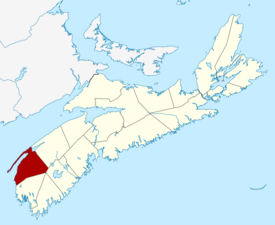Digby County is a county in the Canadian province of Nova Scotia.
Digby County Comté de Digby (French) | |
|---|---|
 Location of Digby County, Nova Scotia | |
| Coordinates: 44°18′N 65°48′W / 44.3°N 65.8°W | |
| Country | Canada |
| Province | Nova Scotia |
| District municipalities | Clare / Digby |
| Towns | Digby |
| Established | 1837 |
| Divided into District Municipalities | April 17, 1879 |
| Electoral Districts Federal | West Nova |
| Provincial | Digby-Annapolis / Clare |
| Area | |
| • Land | 2,512.28 km2 (970.00 sq mi) |
| Population | |
| • Total | 17,062 |
| • Density | 6.8/km2 (18/sq mi) |
| • Change 2011-16 | |
| • Census Rankings - District municipalities Clare Digby - Towns Digby - Reserves Bear River 6 | 8,813 (431 of 5,008) 7,986 (458 of 5,008) 2,092 (2,074 of 5,008) 101 (4,415 of 5,008) |
| Time zone | UTC-4 (AST) |
| • Summer (DST) | UTC-3 (ADT) |
| Area code | 902 |
| Dwellings | 9927 |
| Median income* | CA$38,284 |
| |
History
It was named after the Township of Digby; this was named in honour of Rear Admiral Robert Digby, who dispatched HMS Atalanta to convey Loyalists from New York City in the spring of 1783 to Conway, which became known as Digby, as part of their evacuation and resettlement following the American Revolutionary War. The Crown resettled thousands of Loyalists in Nova Scotia and other areas of Canada. Digby County was established in 1837. Previously, from August 17, 1759, when Nova Scotia was first divided into counties, this area had been part of Annapolis County.
In 1861, Digby County was divided into two sessional districts: Digby and Clare. These were eventually incorporated as district municipalities in 1879.
In addition to these two district municipalities, the county contains the Town of Digby and part of the Bear River Indian (First Nations) reserve. Also, there is Digby Neck leading into the Bay of Fundy to Long Island and Brier Island.
Demographics
As a census division in the 2021 Census of Population conducted by Statistics Canada, Digby County had a population of 17,062 living in 8,117 of its 9,681 total private dwellings, a change of -1.5% from its 2016 population of 17,323. With a land area of 2,512.28 km2 (970.00 sq mi), it had a population density of 6.8/km2 (17.6/sq mi) in 2021.[3]
Mother tongue language (2011)[6]
| Language | Population | Pct (%) |
|---|---|---|
| English only | 11,850 | 66.65% |
| French only | 5,430 | 30.54% |
| Non-official languages | 190 | 1.07% |
| Multiple responses | 305 | 1.72% |
Ethnic groups (2006)[7]
| Ethnic Origin | Population | Pct (%) |
|---|---|---|
| Canadian | 9,265 | 49.5% |
| French | 6,795 | 36.3% |
| English | 5,000 | 26.7% |
| Scottish | 2,655 | 14.2% |
| Irish | 2,295 | 12.3% |
| Acadian | 2,150 | 11.5% |
| German | 1,235 | 6.6% |
| North American Indian | 1,035 | 5.5% |
| Métis | 830 | 4.4% |
| Dutch (Netherlands) | 635 | 3.4% |
Communities
- Towns
- Villages
- Reserves
- District municipalities
Access routes
Highways and numbered routes that run through the county, including external routes that start or finish at the county boundary:[8]
Museums
The county's history is preserved at the Admiral Digby Museum as well as several community museums.
Notable people
See also
References
